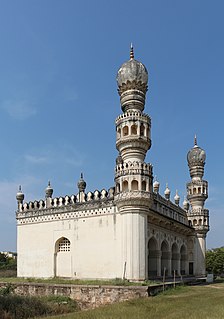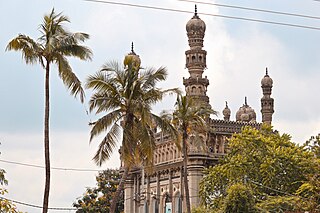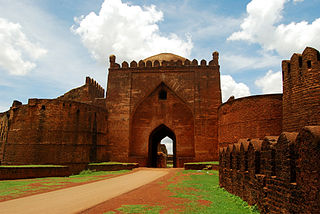The Deccan sultanates were five late-medieval Indian kingdoms—on the Deccan Plateau between the Krishna River and the Vindhya Range—that were ruled by Muslim dynasties: namely Ahmadnagar, Berar, Bidar, Bijapur, and Golconda. The sultanates had become independent during the break-up of the Bahmani Sultanate. In 1490, Ahmadnagar declared independence, followed by Bijapur and Berar in the same year. Golconda became independent in 1518, and Bidar in 1528.

The Charminar, constructed in 1591, is a monument and mosque located in Hyderabad, Telangana, India. The landmark has become known globally as a symbol of Hyderabad and is listed among the most recognized structures in India. The Charminar's long history includes the existence of a mosque on its top floor for more than 400 years. While both historically and religiously significant, it is also known for its popular and busy local markets surrounding the structure, and has become one of the most frequented tourist attractions in Hyderabad. Charminar is also a site of numerous festival celebrations, such as Eid-ul-adha and Eid-ul-fitr.

The Qutb Shahi dynasty ruled the Golconda Sultanate in south India. It was initially a highly Persianate Muslim Turkmen dynasty established in the 16th century that eventually adopted the regional culture of the Deccan. The Qutb Shahis were known for their secular rule.

Makkah Masjid or Mecca Masjid, is a congregational mosque in Hyderabad, India. It is one of the largest mosques in India with a capacity of 20,000. The mosque was built between the 16th and 17th centuries, and is a state-protected monument situated in the heart of the old city of Hyderabad, close to the historic landmarks of Charminar, Chowmahalla Palace and Laad Bazaar.

Musheerabad is a commercial center in Hyderabad, India. Musheerabad comes under central zone and ninth circle of Hyderabad, and falls under the Secunderabad revenue division. Nawab Bahadur Yar Jung, one of the founding members of All India Majlis-e-Ittehadul Muslimeen, is buried in Musheerabad.
Member of legislative Assembly(MLA) :- Muta Gopal (TRS)

The Old City of Hyderabad is a walled city of Hyderabad, Telangana, India, located on the banks of the Musi River built by Qutb Shahi sultan Muhammed Quli Qutb Shah in 1591 AD.

Khairtabad Mosque is in Khairatabad. Today Khairtabad is a well-known locality built around the mosque. The area had become a major business and IT hub of Hyderabad, India.

Hayat Bakshi Mosque also Hayat Bakshi Begum Masjid or Hayathnagar Grand Mosque is a mosque located in Hayathnagar, near Hyderabad, India. It was constructed in 1672 during the reign of Abdullah Qutb Shah the fifth Sultan of Golconda.

Naya Qila is an extended portion of Golkonda Fort in Hyderabad, India. It was built in 1656 by Sultan Abdullah Qutb Shah as further defence for the Mughal armies. This integral part of the Golkonda fort contains many historic structures. There are strange figures and animals worked out of stone and stucco on the walls of the outer fort facing the Naya Qila. It is one of the least explored heritage sites of India, partly because it has become part of a golf course, which makes access for visitors complicated.

Toli Masjid, also known as Damri Masjid, is a mosque in Karwan, Hyderabad, India. It is 2 km from the Golconda fort on the way to Charminar. Built by Mir Musa Khan Mahaldar during the reign of Abdullah Qutb Shah in. This mosque is INTACH awarded and a declared heritage site by Archaeological Survey of India. On scale of architecture Toli Mosque ranks next after Mecca Masjid, Hyderabad, India.

Hyderabad is the capital of the Indian state of Telangana. It is a historic city noted for its many monuments, temples, mosques and bazaars. A multitude of influences has shaped the character of the city in the last 400 years.

The Deccan sultanates were five dynasties that ruled late medieval kingdoms, namely, Bijapur, Golkonda, Ahmadnagar, Bidar, and Berar in south-western India. The Deccan sultanates were located on the Deccan Plateau. Their architecture was a regional variant of Indo-Islamic architecture, heavily influenced by the styles of the Delhi Sultanate and later Mughal architecture, but sometimes also directly from Persia and Central Asia.
The localities and neighborhoods of Hyderabad have a unique oral history, since the time of the Qutb Shahi dynasty, over 400 years ago, and they are named after various people and things. Some are named after a major building or structure in the locality, others named for individuals. The names are mostly in Telugu and Urdu, the major languages of the city. This is a list of localities, neighborhoods and streets of Hyderabad and their etymology.

The City Wall of Hyderabad was a city wall surrounding Hyderabad, although the city has expanded significantly beyond the wall. The wall used to enclose the area of present Old City of Hyderabad. The wall was around 6 miles (9.7 km) long and covered an area of 41 miles. made of large granite blocks which were abundantly available around the city.

Kulsum Begum Masjid is a mosque in the Karwan locality of Hyderabad, India. It was built in the 17th century by Kulsum Begum, daughter of Sultan Muhammad Qutb Shah.
The architecture of Telangana dates back thousands of years.

A distinct Indo-Islamic architecture style with local contribution is reflected in the historical buildings of Hyderabad, making it the first and "Best Heritage City of India" as of March 2012. The city houses many famous historical sites constructed during Qutb Shahi and Asaf Jahi period, including various mosques and palaces.

Qutb Shahi architecture is the distinct style of Indo-Islamic architecture developed during the reign of the Qutb Shahi dynasty, also known as the Golconda Sultanate.
Hyderabad, is the capital of the Indian state of Telangana and de jure capital of Andhra Pradesh. It was established by Qutb Shahi sultan Muhammad Quli Qutb Shah in 1591 AD to expand their capital beyond the Golconda fort. The Charminar Masjid was constructed upon the inception of Hyderabad, the iconic mosques of Mecca Masjid and Hayat Bakshi Mosque were constructed during this dynasty and these style of architecture is known as Qutb Shahi Masajid—(Qutb Shahi Mosques). In 1769 AD when the city became capital of the Nizams of Hyderabad—(also known as Asaf Jahi dynasty), they had constructed many mosques in the process to expand the city, Afzal Gunj Masjid and Shahi Masjid are the resemblance of Asaf Jahi Masajid—(Asaf Jahi Mosques). Some of the iconic mosques in Hyderabad such as Toli Masjid, Mian Mishk Masjid, Spanish Mosque and Paigah Mosque were constructed by the prominent nobles of the former rulers of Hyderabad state.















